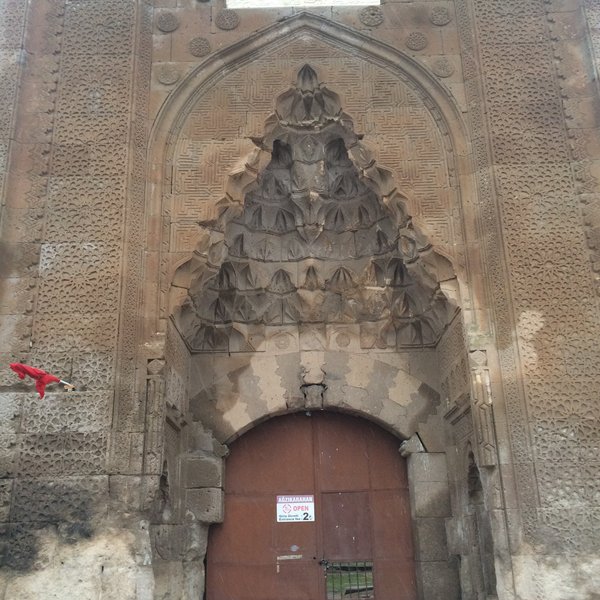 |
| Niche rug, Central Anatolia 17th, Alaeddin mosque - Konya found, TIEM |
An extraordinary rug with an extraordinary niche shape.
The carpet was found in the properties of the venerated old Alaeddin mosque in Konya. Expertly comments faintly mention the very long niche.
The eye should also point to the vault profile only superficially bizarre. It is hard not to detect the attempt of the weaver to render a difficult design. In fact, with the exception of the first fold on the right side, the drawing appears well mirrored in both sides as if actually an interpretation of a definite image.
The medieval Seljuk architecture in Konya curiously offers several examples of similarly drawn arches in crown doors, or portals, and mihrabs. The livery of the city's most important buildings is due to the most renowned of the Seljuk Sultans, Alaeddin Keyqubad I (r. 1220-1237). Although not an innovator he was a sensible interpret of his time and, specifically, architecture. A family affair indeed, if also one of his wives, the Greek Mahperi Hatun, used her influence, wealth, and creative intelligence to commission an important series of monuments after the death of her husband.
 |
| Mahperi Hatun mosque, crown door, 1238, Kayseri |
Keyqubad I the Great signed the apogee of the Seljuk power and cultural influence in Anatolia leaving a momentous legacy of culture and architecture gracing tows and deserted plains. Apart from reconstructing towns and fortresses, he made built many mosques, medreses, caravanserais, bridges, and hospitals. Konya, Kayseri, Sivas, Alanya, Erzurum, Van, Ahlat bear his cultural marks . Besides completing the royal palace in Konya, he also erected the Kubadabad on the shore of Lake Beysehir and a winter palace in Kayseri.
A unique stylistic mark of this legacy appears in the crown doors, or portals, and mihrabs. The indented vault profile presents the alternating sections of the muqarnas decorating its carved surface. In the stone or stucco works the profile can follow the curved and angular sections giving a sense of nearly cluttered drawing from a distance, because of the variety of the muqarnas' vault shape. The tile mihrabs, otherwise, simplify the design using only a type of section, the angular, because mostly the muqarnas have not a curve vault themselves. Finally, the mihrabs render a stepped profile more or less sharp, the doors a lobed.
 |
| Dundar Bey medrese, 1238 Igidir lake |
 |
| Seljuk medrese, Kayseri (winter station of Keyqubad I) |
 |
| Sahip Ata mosque, tile mihrab, 1258-1283, Konya |
 |
| Beyhekim mosque in Konya, mihrab, 1270, Museum of Islamic Art Berlin |
One specific mark appears in the carpet design, the exceedingly tall vault and the relatively short sides.
Long vaults are not unusual though.
 |
| Esrefoglu mosque, Beyshehir |
The triangle connecting vault and side in the carpet appears in tune with the tile mihrab where a diamond functions as reduced capitel as well as the column pedestal is. But even stone crown doors present the same feature.
 |
| Beyhekim mosque detail |
 |
| Agzikarahan caravanseray portal, Cappadocia |
This styled niche enjoyed a long life during the Ottoman period.
In the 15th century
 |
| Hasbey-Darul-Huffazi mihrab, Konya, 1421 |
 |
| Ibrahim Bey Imaret in Karaman, 1432 |
In the 16th century
 |
| Suleymaniye mosque, Istanbul 1550-1557 |
Just a handful of decades separates these last examples from the carpet at issue.
Should be remembered also that Keyqubad's fame survived over the centuries: streets, squares, and important buildings were entitled to him.
Even deserted plains bear his landmark in the caravanserais he commissioned where again the vault drawing reverberates his name.
 |
| Sultan Keyqubad I han, Sultanhani Aksaray province |
The fact that the carpet resided in the Konya mosque shows irresistible evidence of it being inspired by the Sultan's Crown Door type or mihrab.
This short overview of Anatolian Ottoman vaults suggests explaining other Anatolian Ottoman niche carpets dated to the 17th century.
Loosely inspired by the Keyqubad-type vault some niches in the 'Transylvanian family too.
But there are some exemplars where the niche profile seems quite swaying echoing the celebrated mihrab in the Damascus Umayyad Mosque showing a geometric-like swaying to follow the cross section of the interior muqarnas work.
 |
| Detail of the Umayyad mosque mihrab in Damascus |
 |
| Hali photocredits |
 |
| Transylvanian plain niche carpet, Anatolia, 17th, Germanisches National Museum Nurember, S. Ionescu photocredits |
Strictly inspired by a diminished typical vault is this 'Transylvanian' stepped niche type
 |
| Stepped niche, Anatolian Ottoman carpet 17th |
 |
| Cifte minareli medrese, detail of the crown door, Erzurum |
Many are the epigones in the diverse provinces of Anatolia in the 18th and 19th centuries such as the reader can discover them at his leisure not neglecting the kilim area.
 |
| Niche kilim, Ghiordes, dated 1774, the Metropolitan Museum |
One for all the renowned Ladik stepped niche carpets
 |
| Stepped niche carpet, Ladik - Konya region, circa 1800, Saint Louis Museum |
Note
After the publication of this entry, I came across a note by Ralph Kaffel on the carpet at issue published in Hali, Autumn 2008 p. 87
Bibliography
Arık, R., Kubad Abad, Istanbul, 2000.
Aslanapa, O., Anadolu'da Türk çini ve Keramik Sanatı (Turkish Art of Tile and Pottery in Anatolia), Ankara, 1965.
Oral, Z., “Kubad Abad çinileri (Kubad Abad Tiles)”, Belleten, Vol. XVII, Issue: 66, Ankara, 1959, pp.209–22.
Önder, M., “Selçuklu Devri Kubad Abad Sarayı çini Süslemeleri (The Seljuq Period Tile Decoration of Kubad Abad Palace)”, Türkiyemiz6 (1972), pp.15-18.
Öney, G., Turkish Tile Art, Istanbul, 1976.
Roxburgh, D. J. (ed), Turks: A Journey of a Thousand Years, 600–1600, London, 2005
Saljuq_buildings_-the_introduction_of_an_Iranian_decorative_technique_into_the_architecture_of_Anatolia, McClary 2013
S. Ionescu, Antique Ottoman Rugs in Transylvania, 2006

No comments:
Post a Comment
Note: only a member of this blog may post a comment.